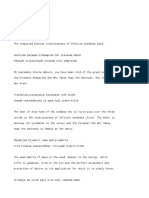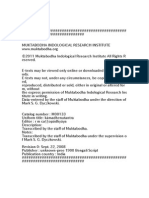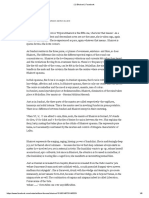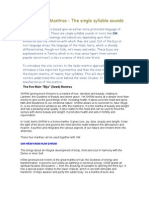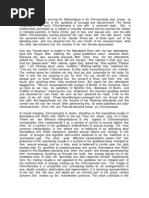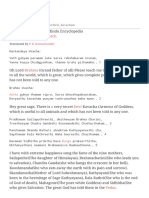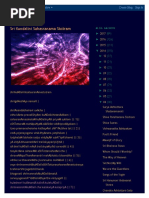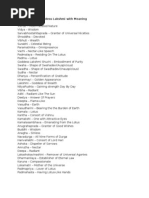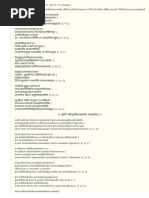100%(1)100% found this document useful (1 vote)
686 viewsBhairavi
Bhairavi
Uploaded by
Pradyot RoyBhairavi is a fierce and terrifying aspect of the Goddess, virtually indistinguishable from Kali. She embodies the principle of destruction in the world. Destruction, through processes like aging, weakness, and death, allows for continued creation through transformed energy. Bhairavi is associated with both destructive forces in the world like anger and self-destructive habits, as well as sexual desire and fulfillment. She is seen as an ever-present goddess who manifests in all destructive aspects of life and the world.
Copyright:
© All Rights Reserved
Available Formats
Download as DOCX, PDF, TXT or read online from Scribd
Bhairavi
Bhairavi
Uploaded by
Pradyot Roy100%(1)100% found this document useful (1 vote)
686 views1 pageBhairavi is a fierce and terrifying aspect of the Goddess, virtually indistinguishable from Kali. She embodies the principle of destruction in the world. Destruction, through processes like aging, weakness, and death, allows for continued creation through transformed energy. Bhairavi is associated with both destructive forces in the world like anger and self-destructive habits, as well as sexual desire and fulfillment. She is seen as an ever-present goddess who manifests in all destructive aspects of life and the world.
Original Description:
Bhairavi devi
Copyright
© © All Rights Reserved
Available Formats
DOCX, PDF, TXT or read online from Scribd
Share this document
Did you find this document useful?
Is this content inappropriate?
Bhairavi is a fierce and terrifying aspect of the Goddess, virtually indistinguishable from Kali. She embodies the principle of destruction in the world. Destruction, through processes like aging, weakness, and death, allows for continued creation through transformed energy. Bhairavi is associated with both destructive forces in the world like anger and self-destructive habits, as well as sexual desire and fulfillment. She is seen as an ever-present goddess who manifests in all destructive aspects of life and the world.
Copyright:
© All Rights Reserved
Available Formats
Download as DOCX, PDF, TXT or read online from Scribd
Download as docx, pdf, or txt
100%(1)100% found this document useful (1 vote)
686 views1 pageBhairavi
Bhairavi
Uploaded by
Pradyot RoyBhairavi is a fierce and terrifying aspect of the Goddess, virtually indistinguishable from Kali. She embodies the principle of destruction in the world. Destruction, through processes like aging, weakness, and death, allows for continued creation through transformed energy. Bhairavi is associated with both destructive forces in the world like anger and self-destructive habits, as well as sexual desire and fulfillment. She is seen as an ever-present goddess who manifests in all destructive aspects of life and the world.
Copyright:
© All Rights Reserved
Available Formats
Download as DOCX, PDF, TXT or read online from Scribd
Download as docx, pdf, or txt
You are on page 1of 1
The fifth form of Mahavidya is Sri Bhairavi Amman.
Bhairavi is a fierce and
terrifying aspect of the Goddess virtually indistinguishable from Kali, except for
her particular identification as the consort of the Wrathful Shiva. She is
considered the female form of Lord Shiva known as Bhairava. Creation and
Destruction are two essential aspects of the universe, which is continually
subject to their alternating rhythms. The two are equally dominant in the world
and indeed depend upon each other in symbiotic fashion. Bhairavi embodies the
principle of destruction. She arises or becomes present when the body declines
and decays, which is a natural,
inevitable, and irresistible force. Bhairavi is also evident in self- destructive
habits, such as eating tamsic food (food having a quality associated with
ignorance and lust) and drinking liquor, which wear down the body and mind.
She is present; it is said, in the loss of semen, which weakens males. Anger,
jealousy, and other selfish emotions and actions strengthen Bhairavi"s
presence in the world. Righteous behaviour, conversely, makes her weaker. In
short, she is an ever-present goddess who manifests herself in, and embodies,
the destructive aspects of the world. Destruction, however, is not always
negative, creation cannot continue without it. This is most clear in the process
of nourishment and metabolism, in which life feeds on death; creation proceeds
by means of transformed energy given up in destruction.
Bhairavi is also identified with Kalaratri, a name often associated with Kali that
means "black night (of destruction)" and refers to a particularly destructive
aspect of Kali. She is also identified with Mahapralaya, the great dissolution at
the end of a cosmic cycle, during which all things, having been consumed with
fire, are dissolved in the formless waters of procreation. She is the force that
tends toward dissolution. This force, furthermore, which is actually Bhairavi
herself, is present in each person as one gradually ages, weakens and finally
dies. Destruction is apparent everywhere, and therefore Bhairavi is present
everywhere.
One of her dhyana mantras, that of Sampatprada-bhairavi, says that she is
intoxicated with her youth, and most descriptions of her, despite her association
with destruction, say that she is attractive, young, and shapely. Bhairavi"s
association with sexual desire and fulfilment is mentioned often in her
thousand-name hymns. In the Shakta-pramoda, for example, she is called She
Who Is Fond of Semen and Menstrual Blood and She Who Is Worshiped by
Those Who Worship with Semen. In her thousand-name hymn in the
Vishvasara-tantra, she is called Lovely One, She Whose Form Is Semen, Who
Produces Semen, Who Gives Love, Who Enjoys Sexual Intercourse, Who Is
Dear To Kama, and Who Dwells in the Yoni. She is shown here seated on a
lotus, with four arms, two of them making the gestures of granting boons and
removing fear respectively. The other two hands hold a goad and noose.
Bhairavi has facets and epithets that assert her cosmic importance, if not
supremacy. A commentary on the Parashurama-kalpasutra says that the name
Bhairavi is derived from the words bharana (to create), ramana (to protect), and
vamana (to emit or disgorge). The commentator, that is, seeks to discern the
inner meaning of Bhairavi"s name by identifying her with the cosmic functions
of creation, maintenance, and destruction.
You might also like
- Brahm Kavach - Shakti MantraDocument1 pageBrahm Kavach - Shakti MantraAnna Nuscky80% (15)
- Introduction To Sanskrit Part 1 - Thomas EgenesDocument404 pagesIntroduction To Sanskrit Part 1 - Thomas EgenesDevlinPyx100% (6)
- Bhairava Kali Dharma SampleDocument8 pagesBhairava Kali Dharma SampleDaniel B.No ratings yet
- Navratri Puja English PDF - by Ashika PDocument8 pagesNavratri Puja English PDF - by Ashika Pveerandra yadav karriNo ratings yet
- Kali KavachDocument6 pagesKali KavachrudraNo ratings yet
- Book 3 Durga Puja PDFDocument221 pagesBook 3 Durga Puja PDFHanif Ali Molla100% (1)
- Sankalp MantraDocument1 pageSankalp MantraPradyot Roy100% (1)
- Shiv Stuti MantraDocument3 pagesShiv Stuti MantraPradyot Roy67% (3)
- Beejas For MantrasDocument15 pagesBeejas For Mantrasbikergal100% (5)
- Kali KavachDocument10 pagesKali KavachUmesh Kumar Sharma Ramamoorthi0% (1)
- KāmadhenutantraDocument38 pagesKāmadhenutantraAlejandro MachucaNo ratings yet
- Devi Puja PDFDocument24 pagesDevi Puja PDFtheojulien100% (1)
- Bhairavi - FacebookDocument8 pagesBhairavi - FacebookMislioc TragateljNo ratings yet
- Forms of BhairavaDocument4 pagesForms of BhairavaAleksey Dobryy100% (1)
- Das MahaVidyasDocument43 pagesDas MahaVidyaskiran_vedanteNo ratings yet
- Das MahaVidyasDocument36 pagesDas MahaVidyaskiran_vedante100% (1)
- Ardhanarishvara Stotra: A Hymn on Unified Form Of Shiva and Shakti by Shankara BhagavadpaadaFrom EverandArdhanarishvara Stotra: A Hymn on Unified Form Of Shiva and Shakti by Shankara BhagavadpaadaNo ratings yet
- Bhairava Dashanama Stotra : Ten Names of Bhairava to Overcome Pain and SufferingFrom EverandBhairava Dashanama Stotra : Ten Names of Bhairava to Overcome Pain and SufferingNo ratings yet
- Kalabhairavashtakam : Eight Verses on Kalabhairava By Shankara BhagavadpaadaFrom EverandKalabhairavashtakam : Eight Verses on Kalabhairava By Shankara BhagavadpaadaNo ratings yet
- Sri Devi Khadgamala Stotram EnglishDocument4 pagesSri Devi Khadgamala Stotram Englishextra_hack@yahoo.comNo ratings yet
- Abstract of Dakshinamurti SamhitaDocument3 pagesAbstract of Dakshinamurti SamhitaRavindra Shinde100% (1)
- BhairavaDocument5 pagesBhairavaMuthukumaran A100% (1)
- Sri VidyaDocument3 pagesSri VidyaUmashakti Peeth0% (1)
- 1.6 MatangiDocument8 pages1.6 MatangiallandzxNo ratings yet
- Chamunda 108Document3 pagesChamunda 108Misty LakeNo ratings yet
- Devi Varahi MantraDocument1 pageDevi Varahi MantraescribitoNo ratings yet
- Kaulajnananirnaya TantraDocument2 pagesKaulajnananirnaya TantraSean GriffinNo ratings yet
- Sapta Matrikas - The Seven Divine MothersDocument6 pagesSapta Matrikas - The Seven Divine MothersSrisrisri Ravi Shankar100% (1)
- Ashta Bhairav)Document26 pagesAshta Bhairav)Swami AbhayanandNo ratings yet
- Ambigai and DasavatharamDocument17 pagesAmbigai and DasavatharamShankarr KshanNo ratings yet
- The Kali YantraDocument4 pagesThe Kali YantraKumarjit Kolay0% (1)
- Nada Bindu Kala ExpDocument24 pagesNada Bindu Kala Expprasad GabbitaNo ratings yet
- Bagalamukhi Kavacham Rudrayamale IAST and Devanagari CombinedDocument5 pagesBagalamukhi Kavacham Rudrayamale IAST and Devanagari CombinedRNNo ratings yet
- Kulachudamani TantraDocument11 pagesKulachudamani TantraAlejandro MachucaNo ratings yet
- Dash MahavidyaDocument30 pagesDash MahavidyaAnonymous gyOsTU5No ratings yet
- Maha Ganapati Mool Mantra LyricsDocument3 pagesMaha Ganapati Mool Mantra LyricsMarcio Piza0% (1)
- Chamunda Mantra 108 Times by Sadhna Sargam With Detailed MeaningDocument2 pagesChamunda Mantra 108 Times by Sadhna Sargam With Detailed MeaningJagadeesh SundaramNo ratings yet
- Goddess Lalitha TrishatiDocument3 pagesGoddess Lalitha TrishatiBryanNo ratings yet
- Ashta BairavarDocument7 pagesAshta BairavarSanatana DharmaNo ratings yet
- Shani Amavasya in Year 2016Document32 pagesShani Amavasya in Year 2016vinulalNo ratings yet
- Paraprāsāda MantraDocument3 pagesParaprāsāda MantraCelestial ProphecyNo ratings yet
- Bhairav Chalisa EnglishDocument8 pagesBhairav Chalisa Englishnaresh bhusalNo ratings yet
- Sundari Shyamala and VarahiDocument4 pagesSundari Shyamala and VarahiAnilkumar Shankarbhat Nagarakatti100% (1)
- Bhairava's Royal Brahmanicide - Elizabeth-Chalier VisuvalingamDocument34 pagesBhairava's Royal Brahmanicide - Elizabeth-Chalier VisuvalingamRadha Viswanath100% (1)
- Ugra Tara or MahaChina TaraDocument2 pagesUgra Tara or MahaChina TaraAnand SharmaNo ratings yet
- Gupta Sadhan TantraDocument4 pagesGupta Sadhan TantraRajesh Tanti100% (1)
- Bija MantrasDocument9 pagesBija MantrasThomas Dale100% (1)
- The Soma TantraDocument95 pagesThe Soma TantraCristina Comaniciu100% (1)
- Devi Mahatmyam-English TranslationDocument30 pagesDevi Mahatmyam-English TranslationPraveen Chandrasekar100% (1)
- Hanuman Sathika in EnglishDocument10 pagesHanuman Sathika in EnglishsharwanNo ratings yet
- Adharvana Badra KaliDocument2 pagesAdharvana Badra KaliKambhampati SandilyaNo ratings yet
- Kali: The First Nitya of The Waning MoonDocument5 pagesKali: The First Nitya of The Waning MoonVinay Narahari100% (3)
- Chinnamasta Sadhana PDFDocument1 pageChinnamasta Sadhana PDFSayan Majumdar100% (2)
- Śāpavimocana MantrasDocument3 pagesŚāpavimocana MantrasKatherina FominaNo ratings yet
- Devi RahasyaDocument4 pagesDevi RahasyaAnandh ShankarNo ratings yet
- Shodasi Mantra 4uveenuDocument20 pagesShodasi Mantra 4uveenuVeenu Veenu100% (1)
- Devi Mahatmya and VarahiDocument2 pagesDevi Mahatmya and VarahikrishnaNo ratings yet
- Vipreet Pratyangira Mantra Sadhna Evam SiddhiDocument6 pagesVipreet Pratyangira Mantra Sadhna Evam Siddhiemailock0% (1)
- Devi Sakti and Durga in Her Two FormsDocument13 pagesDevi Sakti and Durga in Her Two FormsMonidipa DeyNo ratings yet
- Bija MantrasDocument3 pagesBija MantrasJyothi Lakshmi67% (3)
- Bala TripurasundhariDocument15 pagesBala TripurasundharinageshsriramNo ratings yet
- PrakataDocument1 pagePrakataLakshminarayana KambhampatiNo ratings yet
- Nitya PujaDocument3 pagesNitya Pujawellbredkannan100% (2)
- Shiva Shakti Mandalam Tantrik Home PageDocument2 pagesShiva Shakti Mandalam Tantrik Home Pageitineo2012No ratings yet
- Tantra of the Srikula Part I The secret of the Dark Goddess NikumbhilaFrom EverandTantra of the Srikula Part I The secret of the Dark Goddess NikumbhilaNo ratings yet
- शिवमहिम्नDocument12 pagesशिवमहिम्नPradyot RoyNo ratings yet
- शिवमहिम्न स्तोत्रDocument13 pagesशिवमहिम्न स्तोत्रPradyot RoyNo ratings yet
- Tara AstakDocument3 pagesTara AstakPradyot RoyNo ratings yet
- Ramkrishna (Khandana Bhava Bandhana)Document1 pageRamkrishna (Khandana Bhava Bandhana)Pradyot RoyNo ratings yet
- Tara Astak, in English and TranslationDocument3 pagesTara Astak, in English and TranslationPradyot Roy100% (1)
- आद्या स्तोत्रम्Document3 pagesआद्या स्तोत्रम्Pradyot RoyNo ratings yet
- A Sanskrit Manual For High Schools, Part 1, For Classes VI - VIII (R. Antoine)Document175 pagesA Sanskrit Manual For High Schools, Part 1, For Classes VI - VIII (R. Antoine)another700100% (36)
- दुर्गाध्यगनम् Durga Dhyan MantraDocument3 pagesदुर्गाध्यगनम् Durga Dhyan MantraPradyot RoyNo ratings yet
- Sri Krishna KirtanDocument341 pagesSri Krishna KirtanPradyot Roy100% (4)
- शिवषडाक्षरस्तोत्रम्Document2 pagesशिवषडाक्षरस्तोत्रम्Pradyot RoyNo ratings yet
- Shiva SuktamDocument1 pageShiva SuktamPradyot RoyNo ratings yet
- Durga SahasranamaDocument14 pagesDurga SahasranamaPradyot RoyNo ratings yet
- ChinnamastaDocument2 pagesChinnamastaPradyot RoyNo ratings yet
- गुरु स्तोत्रम्Document3 pagesगुरु स्तोत्रम्Pradyot RoyNo ratings yet
- Yantra 1Document3 pagesYantra 1Pradyot RoyNo ratings yet
- AcyutastakamDocument2 pagesAcyutastakamPradyot RoyNo ratings yet
- Chinnamasta, Dhumavati MantraDocument1 pageChinnamasta, Dhumavati MantraPradyot RoyNo ratings yet
- Tarapith MahatmyaDocument3 pagesTarapith MahatmyaPradyot RoyNo ratings yet
- Lord Shiva To The Work of Destruction, Brahma To Create and Form The Universe andDocument1 pageLord Shiva To The Work of Destruction, Brahma To Create and Form The Universe andPradyot RoyNo ratings yet
- Mahasamshan of TarapithDocument7 pagesMahasamshan of TarapithPradyot Roy0% (1)
- Hindu Tantric and Shakta Literature (READ DESCRIPTION WITHOUT FAIL)Document245 pagesHindu Tantric and Shakta Literature (READ DESCRIPTION WITHOUT FAIL)sharath kumar.r100% (11)
- Dus Mahavidya MantraDocument1 pageDus Mahavidya MantraPradyot RoyNo ratings yet
- Kami Kaga MaDocument1,033 pagesKami Kaga MaPradyot Roy100% (1)
- List of Bhairava temples - WikipediaDocument8 pagesList of Bhairava temples - Wikipediamuraribasnet1No ratings yet
- Dus Maha VidyaDocument14 pagesDus Maha VidyaHarshadRathodNo ratings yet
- Tantroktam Devi Suktam - Stotra On Devi DurgaDocument4 pagesTantroktam Devi Suktam - Stotra On Devi DurgaPuvvada RaambaabuNo ratings yet
- Agamas About WomenDocument2 pagesAgamas About Womenbooklover27No ratings yet
- Mahalaxmi StutiDocument3 pagesMahalaxmi StutiDmmi Fzco100% (2)
- Devi Kavacham - Hindupedia, The Hindu Encyclopedia+Document9 pagesDevi Kavacham - Hindupedia, The Hindu Encyclopedia+ஆதி வேந்தன்0% (1)
- Shakti PeethasDocument9 pagesShakti PeethasSamrat RakshitNo ratings yet
- Mokshapuri KashiDocument8 pagesMokshapuri KashiKart01100% (1)
- Kundalini Sahasranama StotramDocument13 pagesKundalini Sahasranama StotramJayam Jai MaharajNo ratings yet
- The Concept and Percept of The Sri YantrDocument175 pagesThe Concept and Percept of The Sri YantrrudrakshNo ratings yet
- Pancha Sabhai: Pancha Sabhai Sthalangal Refers To The Temples ofDocument4 pagesPancha Sabhai: Pancha Sabhai Sthalangal Refers To The Temples oframachallaNo ratings yet
- 09 Mahiashasura Mardhini Puja VidhanamDocument10 pages09 Mahiashasura Mardhini Puja Vidhanamadithya4rajNo ratings yet
- Annapoornashtakam (Nityanandakari) Lyrics - Devi Sthothra Maalika - Only On JioSaavnDocument2 pagesAnnapoornashtakam (Nityanandakari) Lyrics - Devi Sthothra Maalika - Only On JioSaavnB DashNo ratings yet
- 108 Names of Goddess Lakshmi With MeaningDocument3 pages108 Names of Goddess Lakshmi With Meaningiubescdeciexist6799No ratings yet
- Ujjaini Maha KaliDocument13 pagesUjjaini Maha Kaliexpertjatak50% (2)
- Kerala 108Document5 pagesKerala 108Learn SkillsNo ratings yet
- Nrsimha SaptakamDocument2 pagesNrsimha SaptakamsrikanthmicNo ratings yet
- ShaktiDocument5 pagesShaktiBrandon AugustineNo ratings yet
- Hindu Tantric Literature - WikipediaDocument6 pagesHindu Tantric Literature - WikipediaDeep GhoshNo ratings yet
- Andhra Pradesh Siva TemplesDocument3 pagesAndhra Pradesh Siva Temples11101955No ratings yet
- 108 Names of Sri DakshinamurthyDocument4 pages108 Names of Sri DakshinamurthyolegNo ratings yet
- Veerabhadra Swamy MantrasDocument6 pagesVeerabhadra Swamy Mantrasगणेश पराजुलीNo ratings yet
- nIlasarasvatIstotra PDFDocument5 pagesnIlasarasvatIstotra PDFKirti Vyas100% (1)
- Argala StotramDocument3 pagesArgala Stotramsree2uNo ratings yet




